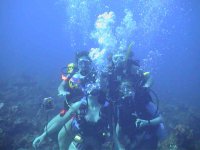I just posted this in another thread so I'll repost it here.
jackson6745 said:
When you come up with a theory LMK please. Seeing Pierces tank confuses the $hit out of me

compared to other SPS reef I have seen.
You sould see Adrian's (ricordiaking) frag tank :lol:.
I've been asking around to see if there are any models for nitrate uptake and if I find them I will post here. I included the accepted model for ammonium uptake by corals at the bottom of this post.
Pierces system has 40ppm nitrates but still has great color and growth in his display. But his frag tank, which he is using old bulbs in, has great growth but not color.
What people believe now is that the coral and zooxanthellae draw from the same pool for carbon. So that when the zoox increase in population they are then outcompeting the coral for C thus preventing the coral from performing calcification. But it has been shown that high levels of ammonium or alkalinity or CO2 can negate the effects of high nitrate on coral growth.
It has also been shown that chlorophyll pigments darken in low light levels (remember they are most effective at specific wavelengths).
Some corals have not been shown to expel zoox. Its assumed that the coral controls zoox growth by limiting transport of nutrients to zoox. But I haven't seen a model that explains what happens to this transport mechanism in high nitrate levels.
Here's what I think and it could be wrong. Peirce might have high levels of zoox in his corals. But something (high levels of ammonium, CO2, alkalinity, or combination) is still allowing him to get good growth. And his lights are providing good enough light (remember he runs a longer MH photoperiod) that his colors are still coming thru; evidenced by the fact that his corals brown in his frag tank.
BTW Rich, I know you told me when we were talking about your fishload coloring up your corals that you thought it was the amino acids from the fish poop. But that is a very small percentage of what the corals actually use. Most of there requirements are met thru ammonium assimilation (the model below) which leads to AA's but this might still fit in well with the large fish population thing.
Click to enlarge.










